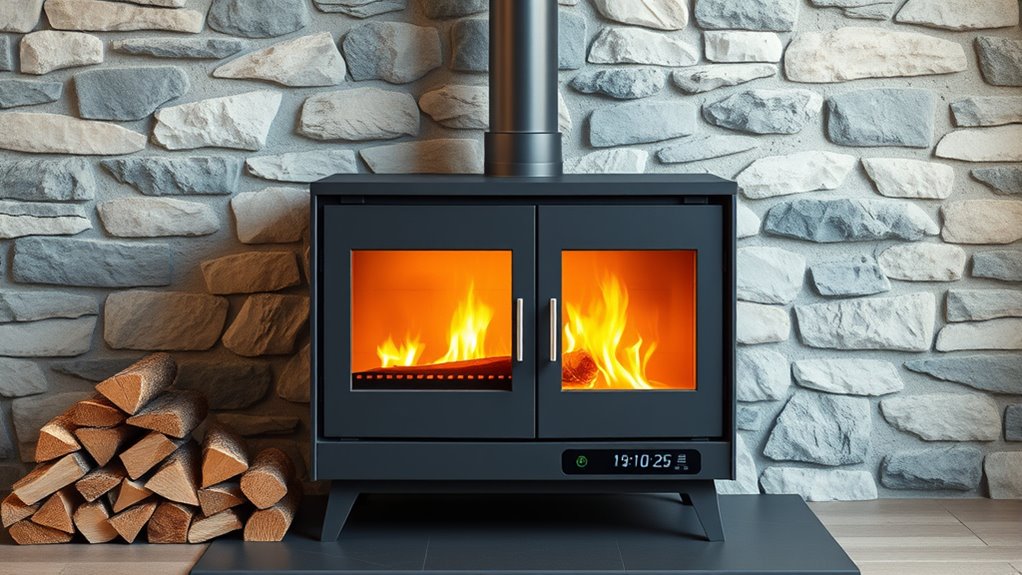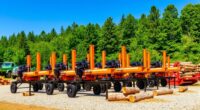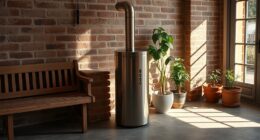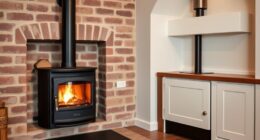Modern wood stoves meet EPA 2020 standards by incorporating advanced combustion features like secondary burn chambers and catalytic converters, which drastically reduce emissions. They use better airflow systems and innovative designs to guarantee complete combustion, producing less smoke and creosote buildup. These stoves also work with cleaner fuels and sustainable materials, helping you stay compliant while staying warm. Keep exploring to discover how these improvements make a real difference for your home and the environment.
Key Takeaways
- Modern wood stoves incorporate secondary burn chambers to ensure more complete combustion and lower emissions.
- They utilize catalytic converters and advanced airflow systems to drastically reduce particulate matter output.
- These stoves are designed with digital controls and smarter technologies to optimize combustion efficiency and emission control.
- They are built with environmentally friendly, sustainable materials to support renewable energy practices.
- Compliance is highlighted through strict emission limits, resulting in cleaner burning, less creosote buildup, and reduced maintenance needs.

As modern wood stoves become more popular for heating, understanding the EPA 2020 standards is essential for homeowners and buyers alike. These standards are designed to ensure that wood-burning appliances contribute less to air pollution while still providing efficient, renewable energy for your home. You might wonder how these regulations impact your choices or the performance of your stove. The EPA’s regulations set strict emission limits, compelling manufacturers to develop stoves that produce markedly lower particulate matter and air pollutants. This means your stove will burn cleaner, producing fewer smoke emissions and improving indoor and outdoor air quality.
Meeting the EPA 2020 standards involves advanced combustion technologies and design improvements. Modern stoves are equipped with secondary burn chambers, catalytic converters, and improved airflow systems that maximize combustion efficiency. These features ensure that the wood burns more completely, reducing creosote buildup and minimizing smoke. As a result, you enjoy better heat output and less maintenance, all while adhering to emission regulations that protect the environment and public health. These technological enhancements make it possible for your stove to produce the same warmth and comfort as older models but with a fraction of the pollution.
Modern stoves with advanced combustion tech burn cleaner, produce less smoke, and require less maintenance while meeting emission standards.
Another way modern stoves meet these standards is through the use of cleaner-burning fuels and carefully engineered materials. Manufacturers now select components that support more complete combustion, further lowering emissions. This focus on cleaner fuel use aligns with the broader goal of renewable energy sources, as wood remains a sustainable, renewable resource when harvested responsibly. By choosing compliant stoves, you support environmentally friendly energy practices, reducing your carbon footprint without sacrificing comfort.
The EPA 2020 standards also encourage innovation within the industry, leading to a wider array of high-efficiency, low-emission models. When shopping for a new stove, you’ll find that many options now prominently advertise their compliance with these standards, giving you confidence that you’re making an environmentally conscious decision. These stoves often feature digital controls and smarter combustion technologies that optimize performance and emissions in real-time. By meeting or exceeding EPA requirements, these appliances prove that you can enjoy renewable energy solutions that respect emission regulations, ensuring cleaner air and a healthier environment.
Frequently Asked Questions
How Do EPA Standards Impact Wood Stove Pricing?
EPA standards increase wood stove prices because manufacturers face higher cost implications to develop cleaner-burning models. As a result, you may notice some stoves cost more, but this also means better efficiency and reduced emissions. The standards can limit market availability initially, but over time, more models become accessible, offering a range of options at different price points. Ultimately, these regulations aim to benefit you with cleaner, more efficient heating solutions.
Are Epa-Compliant Stoves More Energy-Efficient?
Yes, EPA-compliant stoves are more energy-efficient. They use advanced combustion technology to maximize fuel efficiency, meaning you get more heat from less wood. Plus, these stoves considerably reduce emissions, making them environmentally friendly. By meeting strict standards, they help you save on fuel costs while minimizing your carbon footprint. Overall, EPA-compliant stoves deliver better performance, lower emissions, and increased fuel efficiency, benefiting both your wallet and the environment.
Can Old Wood Stoves Be Upgraded to Meet EPA 2020 Standards?
Yes, you can upgrade your old wood stove to meet EPA 2020 standards. Retrofit options are available that help reduce emissions, often involving new catalytic converters or improved combustion technology. You’ll need emissions testing to ensure the upgrade complies with current regulations. This process can improve efficiency and markedly lower emissions, making your stove environmentally friendly and compliant with modern standards.
What Maintenance Is Required for Epa-Compliant Stoves?
Ever wondered what it takes to keep your EPA-compliant stove running efficiently? Regular maintenance is key. You should routinely check and replace the air filter to guarantee proper airflow and combustion. Additionally, chimney cleaning is essential to prevent creosote buildup, which can cause dangerous smoke and fire hazards. By staying on top of these tasks, you’ll maintain peak performance and meet EPA standards effortlessly.
Do EPA Standards Affect Wood Stove Installation Requirements?
Yes, EPA standards influence wood stove installation requirements. You need to guarantee proper ventilation to meet safety and emission standards, which involves following specific ventilation requirements. Additionally, your stove must pass emission testing procedures to confirm it adheres to the limits set by EPA 2020. Proper installation helps minimize emissions, improves efficiency, and ensures your stove operates safely and legally in your home.
Conclusion
So, while modern wood stoves now proudly boast compliance with EPA 2020 standards, you might wonder if they truly warm your home or just your conscience. It’s ironic how these high-tech stoves, designed to reduce pollution, often seem more about ticking boxes than cozy fireside chats. Still, at least you can enjoy a crackling fire knowing you’re technically doing your part—whether or not it actually keeps you warmer.











